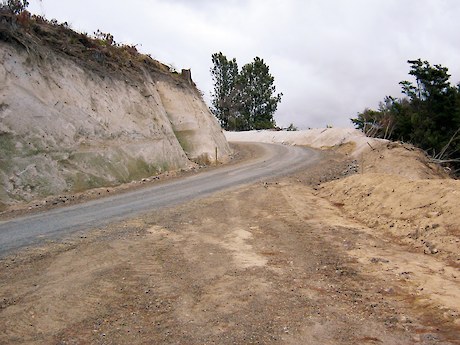 Consider full road design, especially where the road grade is approaching maximum limits, terrain is steep, and where other factors need careful operational planning.A key step is deciding whether a full road design is required. A full road design can be time-consuming and challenging due to the surveying requirements, detailed design work, the laying out of the pegs in the field, and the need for road construction operators who can follow the plans.
Consider full road design, especially where the road grade is approaching maximum limits, terrain is steep, and where other factors need careful operational planning.A key step is deciding whether a full road design is required. A full road design can be time-consuming and challenging due to the surveying requirements, detailed design work, the laying out of the pegs in the field, and the need for road construction operators who can follow the plans.
A full road design provides detailed plans for road and skid construction. At any point on the proposed infrastructure, the location and earthwork details around quantities of cut or fill, and specifics like cut slope height and the location of the toe of the fill, are known. In order to get this level of detail, the base information needs to be precise, otherwise the plans will not be accurate. Larger roading projects will typically be a combination of sections laid out directly in the field, with full design for only the more challenging segments, such as those with extensive earthmoving, where it cuts across steep terrain, or where switchbacks are required.
Advantages of undertaking a full geometric road design include:
- The cost of road construction is likely to be reduced, because alternatives can be evaluated and the optimum design selected
- There is greater reliability that the required road width will be achieved and the maximum gradient limits on the road will not be exceeded in the final road construction
- The earthworks volumes can be predicted in advance, so the cost of construction can be estimated with better accuracy and reliability
- The height of batter slopes can be predicted in advance for consent purposes
- Better set-out information can be provided to the construction crew or contractor
- Better decisions can be made as to whether a road is feasible in marginal locations
- The design software can assist in minimising cut and fill depths
- Where the road is designed and pegged accurately, a corridor can be marked to fell only the necessary trees, thereby minimising the number of roadline trees to be felled. For example, this may be important in areas that are susceptible to windthrow.
Full road design is best done by those who have planned the approximate road and landing locations. They will have the big picture view of what they want to achieve and, having walked the terrain, a good sense of where the potential construction challenges lie.
Designing roads requires competent technical skills. If these are not available in-house, then contract the work out to a professional.